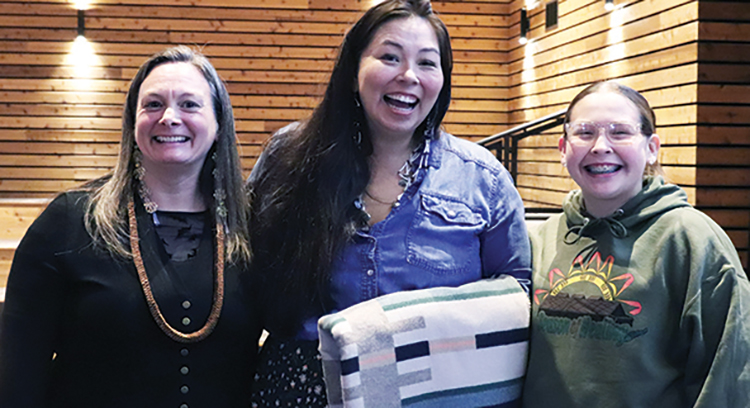
Theresa Sheldon, Matika Wilbur and Lilly Jefferson.
By Wade Sheldon, Tulalip News.
As Tulalip’s Season of Healing comes to a close, it’s time to reflect on the profound teachings and experiences shared among tribal members over the past two months. This period included gatherings over shared meals, giveaways, craft days, mind and spirit work sessions, and presentations from diverse guest speakers—each offering unique insights into healing, resilience, and community. From trauma therapy to traditional foods and spiritual empowerment, each aspect of this season brought a fresh perspective on Indigenous identity, unity, and wellness.
The Season of Healing featured key speakers such as Serene Thin Elk from South Dakota, who shared her expertise in trauma therapy, and Sheldon Smith from the Navajo Nation, who discussed spiritual empowerment. Educator Linzie Crofoot (Tlingit) and Tulalip Native Program member Martin Napeahi also guided the community in conversations about nutrition. Throughout the season, members observed and celebrated Indigenous Peoples Day and Orange Shirt Day with a coastal jam, honoring heritage and the importance of self-respect.
On October 25, artist and advocate Matika Wilbur delivered an inspiring, TED-talk-style event at the Tulalip Gathering Hall. Wilbur shared her journey to understand what it truly means to be Indigenous, discussing how she left behind the familiar to embrace the unknown in her search for new perspectives on Native American life. Wilbur’s insights provided a powerful close to the Season of Healing, encouraging others to explore their identities and stories in the context of community and culture.
Wilbur, a Tulalip and Swinomish citizen, is known for her ambitious project 562, which redefines Native American life through storytelling and art. With a deep commitment to her heritage, she sold her belongings in 2012 and set out across the continent in her RV, “Big Girl,” traveling over 250,000 miles to document the lives and landscapes of over 500 tribal nations. Wilbur challenges stereotypes and brings Indigenous identity’s often-unseen resilience and richness through her photography and narratives.
One of Wilbur’s most memorable encounters was with Wilson and Oliver Hoogendorn, brothers from Nome, Alaska, who defied expectations by summiting Mount Denali without sponsors or professional equipment. Their journey exemplified the strength and determination of Indigenous people, demonstrating an enduring connection to their homelands. “They were there to show their power and resilience,” Wilbur explained, “pushing against every obstacle without losing their sense of purpose and pride.”
Another powerful experience was her visit with the Kumi people in Southern California, where she witnessed the tradition of singing 1,200 songs to welcome a new child into the world. She described these ceremonies as embodying the essence of Native identity, steeped in ancestral wisdom and a profound relationship to land and community. “It’s about carrying on something greater than ourselves,” Wilbur said, “so that our young people can see their heritage alive in today’s world.”
Wilbur’s commitment to storytelling extends beyond photography. Recently, she opened Tideland, a space in Seattle dedicated to Indigenous art, community, and storytelling. “It’s a place where our stories are seen, where our people are understood on our terms,” she shared, reflecting her vision of preserving and elevating Indigenous voices.
Before leading a meditative session, mind, body, and spirit therapist Glendy Morrison shared her journey of healing and transformation. Morrison spoke about overcoming her struggles with trauma, including leaving an abusive marriage, re-evaluating respect, and understanding the impact of trauma. She emphasized the importance of self-reflection, explaining how her role as a healer has evolved through “turning the mirror inward” and embracing vulnerability. Morrison encouraged attendees to explore their own stories as they confront and understand the layers of their experiences.
BOD member Theresa Sheldon reflected on the initiative, which she described as a “safe space…where we could talk about tough issues, hard issues, real issues.” She acknowledged that grounding oneself can be challenging, especially for those with busy minds. She said, “For those of us whose brains never stop, taking this time to ground ourselves is a challenge, and being able to focus on breath and moments—I’m grateful for that.”
Sheldon shared how the initiative grew from a community desire to come together, discuss difficult topics, and foster a supportive environment. “Sometimes acknowledging is the first step,” she emphasized, “and then the second is, what do we do with it once we know the name of it…or the words we’ve always been living our whole life.” She also encouraged community members to help shape the future of this initiative, expressing excitement for continued growth and feedback. “Maybe it’s something monthly; maybe it’s something else,” she suggested. “We have a Board of Directors right now that wants to focus on healing and wellness and to break down barriers.”
Concluding the season with Wilbur’s presentation underscored the power of Indigenous storytelling and the ongoing journey of self-representation and healing for Native communities. The Season of Healing laid the groundwork for future gatherings and ongoing support for those committed to healing and cultural empowerment, ensuring the conversation continues.
If you are a member of the Tulalip Tribes and missed any of the Season of Healing events, you can watch them at IamTulalip.com.